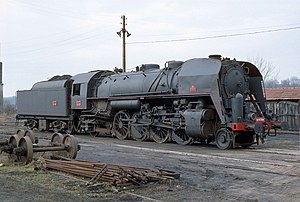SNCF Class 141R
| SNCF 141.R | |||||||||||||||||||||||||||||
|---|---|---|---|---|---|---|---|---|---|---|---|---|---|---|---|---|---|---|---|---|---|---|---|---|---|---|---|---|---|

141 R 568 at Gray on 1981-11-27
|
|||||||||||||||||||||||||||||
|
|||||||||||||||||||||||||||||
|
|||||||||||||||||||||||||||||
|
|||||||||||||||||||||||||||||
| Type and origin | |
|---|---|
| Power type | Steam |
| Total produced | 1340 |
| Specifications | |
|---|---|
| Configuration: |
|
| • Whyte | 2-8-2 |
| • UIC | 1′D1′ h2 |
| Gauge | 4 ft 8 1⁄2 in (1,435 mm) |
| Driver dia. | 1.65 m (65 in) |
| Length | 14.64 m (48 ft 0 in) (loco only) 24.13 m (79 ft 2 in) (total) |
| Loco weight | 115.5 t (113.7 long tons; 127.3 short tons) (coal loco) 116.25 t (114.41 long tons; 128.14 short tons) (oil loco) |
| Tender weight | 75 t (74 long tons; 83 short tons) (30.R tender) |
| Fuel type | Coal or fuel oil |
| Firebox: • Firegrate area |
5.2 m2 (56 sq ft) |
| Boiler pressure | 1.55 MPa (225 psi) |
| Cylinders | Two, outside |
| Cylinder size | 597 mm × 711 mm (23.5 in × 28.0 in) |
| Performance figures | |
|---|---|
| Maximum speed | 100 km/h (62 mph) |
| Power output | 2.154 MW (2,889 hp) at 80 km/h (50 mph) |
| Tractive effort | 202.4 kN (45,500 lbf) |
The SNCF 141 R is a class of 2-8-2 steam locomotives of the Société Nationale des Chemins de fer Français (French State Railways). They were used all over the French rail network from 1945–1974.
At the end of World War II, there was a shortage of locomotives, and to quickly obtain the large number needed locomotives were ordered from the main American and Canadian locomotive builders under the Lend-Lease Program (and not the Marshall Plan, signed in April 1948, as often written).
The design was based on the Green Bay & Western Railroad's successfully customised Mikados, based somewhat on the USRA Light Mikado, suitably modified to meet the SNCF loading gauge. Modifications included the overall height, the fitting of European couplers and buffers, left-hand drive, smoke deflectors (to a unique and instantly recognisable style) and a Kylchap exhaust on the second batch.
The first order for 700 engines was placed in February 1945 with production split between the "big three" American locomotive builders: Baldwin Locomotive Works, Philadelphia, Pennsylvania, American Locomotive Company, Schenectady, New York, and Lima Locomotive Works, Lima, Ohio. Once financing was made available, the second batch of 640 engines was ordered from the "big three", plus the Canadian manufacturers Montreal Locomotive Works, Montreal Quebec and Canadian Locomotive Company, Kingston, Ontario. Most of this batch were built as oil burners, burning preheated heavy fuel oil (known in French as 'Mazout'), unlike the first batch which had all been designed as coal fired.
...
Wikipedia
